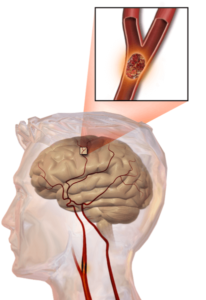It turns out one of the keys to surviving a stroke as you approach middle age could be exercise. A study says that if you exercise regularly during your 40s, your brain could benefit by getting the blood vessels with the health of a 16 year old by the time you turn 70.

Researchers from the University of North Carolina presented their findings at the American Heart Association’s International Stroke Conference in Houston. When one is experiencing a stroke, the damage triggers the body’s Do-It-Yourself mechanism. This process allows a network of collateral vessels, which are small blood vessels running alongside main coronary arteries, to reroute blood flow when arteries constrict and narrow. But these vessels, which can vary in size due to the individual, begin to shrink as the brain ages. And post-stroke, the residual damage to the brain depends on the quality of collateral circulation.
By using rodents, the study showed that exercise is the midlife activity that can strengthen and boost collateral vessels. Researchers found that mice that exercised regularly at 12 months old had the identical quality of collateral vessels when they reached 25 months as seen in mice who were three months.
Related: High Levels of This Inherited Protein May Cause Heart Attack, Stroke
The exercised 25-month-old mice suffered strokes, but their brains had the same healthiness as the mice that were only three months old. Their higher level of molecules helped blood vessels to remain in better health and work properly.

To put that in human terms, it would be the same as a 40 year old starting an aerobic exercise routine that included cycling or jogging; by the time they turned 70 years old, their collateral vessels would have the quality of a 16 year old.
The non-exercising 25-month-old mice had less collaterals which had smaller diameters in circumference.
Women in Menopause Also Benefit From Exercise in Middle Age
There’s more good news for women who are hitting the gym later in life. Regular exercise can benefit their bodies more than when they were younger. Scientists previously thought that the benefits of exercise were rendered useless for women who experienced ‘the change’ of menopause.

But a study says that reduction in oestrogen, which is one of the hormones lost during menopause, actually improves the intake of oxygen in the muscles.
Menopause starts for women in their late 40s to early 50s and marks the time that the body stops making sex hormones like oestrogen.
Research teams at the University of Copenhagen in Denmark tracked 36 women, all in the early 50-year-old age range. Sixteen of the study participants only recently began menopause and 20 had not yet started it. All of the women took part in a 12-week, high intensity cycling training regime. Then, tissue samples were taken to track their thigh muscles’ molecular changes. Results showed that the postmenopausal group had a much better network of blood vessels, and that their bodies supplied more oxygen where it was needed because their muscles adapted better to the exercise.
“These findings suggest that the early postmenopausal phase is associated with an enhanced capacity of the leg vasculature and skeletal muscle mitochondria to adapt to exercise training,” researchers wrote. “The ability to deliver oxygen to match the demand of the active muscles is preserved in the early phase following the menopausal transition.”
Whether you are a man or a woman, menopausal or not, these findings confirm it’s never too late to start an exercise regimen.
Related: Exercise May Reduce Risk of Relapse for Breast Cancer Survivors
Ronke Idowu Reeves is a writer and journalist who hails from Brooklyn, NY. Her news and entertainment stories have appeared on WABC-TV-New York, Fox News Channel, VH1, BET.com plus in Sundance Film Festival’s Sundance Daily Insider and People Magazine.


![How To: ‘Fix’ Crepey Skin [Watch]](https://cdn.vitalupdates.com/wp-content/uploads/2017/05/bhmdad.png)












